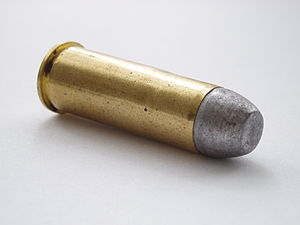.44-40 Winchester
| .44-40 | ||||||||||||||||||||||||
|---|---|---|---|---|---|---|---|---|---|---|---|---|---|---|---|---|---|---|---|---|---|---|---|---|

.44-40 Winchester cartridge
|
||||||||||||||||||||||||
| Type | Rifle/Pistol | |||||||||||||||||||||||
| Place of origin |
|
|||||||||||||||||||||||
| Production history | ||||||||||||||||||||||||
| Designer | Winchester Repeating Arms Company | |||||||||||||||||||||||
| Designed | 1873 | |||||||||||||||||||||||
| Specifications | ||||||||||||||||||||||||
| Bullet diameter | .427 in (10.8 mm) | |||||||||||||||||||||||
| Neck diameter | .443 in (11.3 mm) | |||||||||||||||||||||||
| Shoulder diameter | .457 in (11.6 mm) | |||||||||||||||||||||||
| Base diameter | .471 in (12.0 mm) | |||||||||||||||||||||||
| Rim diameter | .525 in (13.3 mm) | |||||||||||||||||||||||
| Case length | 1.310 in (33.3 mm) | |||||||||||||||||||||||
| Primer type | Large pistol | |||||||||||||||||||||||
| Ballistic performance | ||||||||||||||||||||||||
|
||||||||||||||||||||||||
|
Test barrel length: 20" Source(s): Reloadersnest.com |
||||||||||||||||||||||||
The .44-40 Winchester, also known as .44 Winchester, .44 WCF (Winchester Center Fire), and .44 Largo (in Spanish speaking countries) was introduced in 1873 by the Winchester Repeating Arms Company. It was the first metallic centerfire cartridge manufactured by Winchester, and was promoted as the standard chambering for the new Winchester Model 1873 rifle. As both a rifle and a handgun caliber, the cartridge soon became widely popular, so much so that the Winchester Model 1873 rifle became known as "The gun that won the West."
When Winchester released the new cartridge, many other firearm companies chambered their guns in the new round. Remington and Marlin released their own rifles and pistols which chambered the round, Colt offered an alternative chambering in its popular Single Action Army revolver in a model known as the Colt Frontier Six-Shooter, and Smith & Wesson began releasing their Smith & Wesson New Model 3 chambered in .44-40. Settlers, lawmen, and cowboys appreciated the convenience of being able to carry a single caliber of ammunition which they could fire in both pistol and rifle. In both law enforcement and hunting usage the .44-40 became the most popular cartridge in the United States and to this day has the reputation of killing more deer than any other save the .30-30 Winchester.
The cartridge was originally sold as .44 Winchester. When the Union Metallic Cartridge Co. (U.M.C.) began selling their own version of the cartridge, it adopted the name .44-40 (shorthand for .44 caliber and the standard load at the time of 40-grain (2.6 g) of black powder), as it did not want to offer free advertising for one of its competitors. Over time the name stuck, and eventually Winchester adopted the .44-40 designation for the round after World War II. Winchester uses the designation 44-40 Winchester on packaging.
...
Wikipedia
